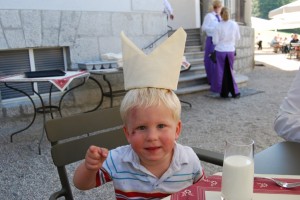Oktoberfest.
Just the word conjures up visions of giant soft, chewy pretzels, liter steins of beer, and throngs of Germans clad in lederhosen and dirndls.
Well, it’s all true.
 Sarah and I took the kids to Munich to experience Oktoberfest, since we had held an Oktoberfest celebration at our house every year for the past three years. Sarah wrote about how we took the kids for a day of carnival rides and cookies, but the next night, Sarah and I got a babysitter (a saint from Canada named Chantal who had just moved to Munich), dressed up in our best trachten and grabbed the U-Bahn to the Theresienwiese to experience Oktoberfest first hand. And let me tell you, the U-Bahn stop at Theresienwiese during Oktoberfest is wall-to-wall Kraut. You must lose all sense of personal space to brave this crowd.
Sarah and I took the kids to Munich to experience Oktoberfest, since we had held an Oktoberfest celebration at our house every year for the past three years. Sarah wrote about how we took the kids for a day of carnival rides and cookies, but the next night, Sarah and I got a babysitter (a saint from Canada named Chantal who had just moved to Munich), dressed up in our best trachten and grabbed the U-Bahn to the Theresienwiese to experience Oktoberfest first hand. And let me tell you, the U-Bahn stop at Theresienwiese during Oktoberfest is wall-to-wall Kraut. You must lose all sense of personal space to brave this crowd.
Like most things, Oktoberfest is now a mutated, bloated, exorbitant continuation of what once was intended as a commemorative celebration of the marriage of Crown Prince Ludwig (soon King Ludwig I) to his bride, Princess Therese of Saxony-Hildburghausen. The marriage took place on October 12, 1810 and the people of Munich were invited to participate in the festivities including horse races. As the horse race was repeated annually, the tradition of Oktoberfest was born.
Oktoberfest features only beer brewed by the six major brewers to brew within the city of Munich (known as the Big Six by me, if no one else): Hofbrau, Spaten, Paulaner, Hacker-Pschorr, Löwenbräu, and Augustiner. You can usually get Weizenbeir, Helles, and of course, the special Oktoberfest beers at the festival. Liter mugs (ein Maß in German) are mandatory and rarely is anything else sold (or tolerated).
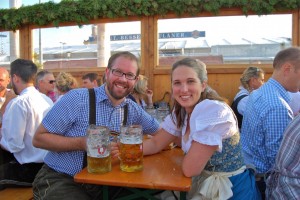 Sarah and I found our way to several tents that all claimed to have reserved seating (though I argued that present paying customers were much better than customers yet to come). You see, at Oktoberfest they will not serve you unless you are seated. So it is not uncommon, if you have a table, for a waiter to escort a pretty young fräulein to your table, sit her down momentarily, exchange beer for money, and then she will get up and walk away. This works with one or two people, but larger groups must find a table to sit at.
Sarah and I found our way to several tents that all claimed to have reserved seating (though I argued that present paying customers were much better than customers yet to come). You see, at Oktoberfest they will not serve you unless you are seated. So it is not uncommon, if you have a table, for a waiter to escort a pretty young fräulein to your table, sit her down momentarily, exchange beer for money, and then she will get up and walk away. This works with one or two people, but larger groups must find a table to sit at.
Eventually we found our seats in the outdoor biergarten of the Schottenhamel tent, a Spaten establishment (one of Sarah and my favorites, and widely available in the U.S. in case you would like to try). We were seated with a group of biology researchers from Munich, across from some Italians from Rome, and a table from some highly inebriated Scots.
We ate, drank, and sang to our hearts delight. Eventually, two nice older couples from Rome were seated next to us. They spoke no German, but understood some of my Spanish. I almost had a seizure trying to translate their Italian into English, and back into German in order to help them order food for the night. They were very appreciative of our efforts, anyway.
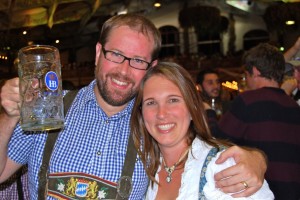 After we drank a few liters we went on to the notorious Hofbrauhaus tent. It is known as the place where loud, obnoxious foreigners (i.e. Australians) go to party. I don’t know where these people were from, but as soon as Sarah and I hit the dance floor everyone seemed to want to take pictures with us. We felt like celebrities (but knew we weren’t).
After we drank a few liters we went on to the notorious Hofbrauhaus tent. It is known as the place where loud, obnoxious foreigners (i.e. Australians) go to party. I don’t know where these people were from, but as soon as Sarah and I hit the dance floor everyone seemed to want to take pictures with us. We felt like celebrities (but knew we weren’t).
We finally made it back to the U-Bahn and headed back home. We knew we had gotten the full Oktoberfest experience. If only King Ludwig himself could see the party he’s started.

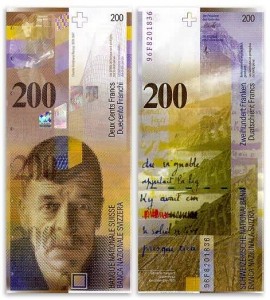
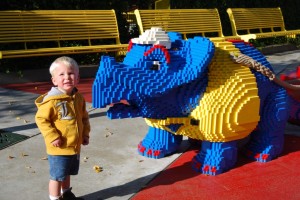
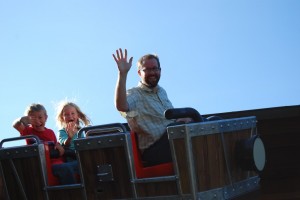
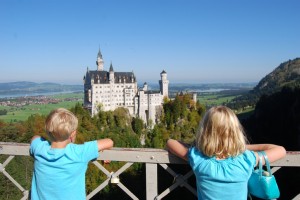
 castle of Hohenschwangau. It is smaller than Neuschwanstein, but has more history as the summer and hunting residence of the Wittelsbach Bavarian royal family. We all watched the sunset over the lake and the castles, which was a beautiful way to end our German vacation.
castle of Hohenschwangau. It is smaller than Neuschwanstein, but has more history as the summer and hunting residence of the Wittelsbach Bavarian royal family. We all watched the sunset over the lake and the castles, which was a beautiful way to end our German vacation.


